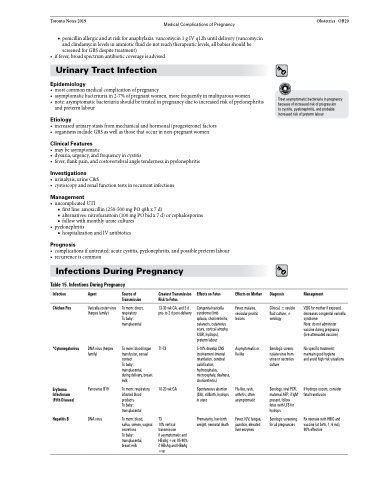Page 869 - TNFlipTest
P. 869
Toronto Notes 2019 Medical Complications of Pregnancy
■ penicillin allergic and at risk for anaphylaxis: vancomycin 1 g IV q12h until delivery (vancomycin and clindamycin levels in amniotic fluid do not reach therapeutic levels, all babies should be screened for GBS despite treatment)
• iffever,broadspectrumantibioticcoverageisadvised
Urinary Tract Infection
Epidemiology
• mostcommonmedicalcomplicationofpregnancy
• asymptomaticbacteriuriain2-7%ofpregnantwomen,morefrequentlyinmultiparouswomen
• note:asymptomaticbacteriuriashouldbetreatedinpregnancyduetoincreasedriskofpyelonephritis
Obstetrics OB29
and preterm labour
Etiology
• increasedurinarystasisfrommechanicalandhormonal(progesterone)factors • organismsincludeGBSaswellasthosethatoccurinnon-pregnantwomen
Clinical Features
• maybeasymptomatic
• dysuria,urgency,andfrequencyincystitis
• fever,flankpain,andcostovertebralangletendernessinpyelonephritis
Investigations
• urinalysis,urineC&S
• cystoscopyandrenalfunctiontestsinrecurrentinfections
Management
• uncomplicatedUTI
■ first line: amoxicillin (250-500 mg PO q8h x 7 d)
■ alternatives: nitrofurantoin (100 mg PO bid x 7 d) or cephalosporins ■ follow with monthly urine cultures
• pyelonephritis
■ hospitalizationandIVantibiotics
Prognosis
• complicationsifuntreated:acutecystitis,pyelonephritis,andpossiblepretermlabour • recurrenceiscommon
Treat asymptomatic bacteriuria in pregnancy because of increased risk of progression
to cystitis, pyelonephritis, and probable increased risk of preterm labour
Infections During Pregnancy
Table 15. Infections During Pregnancy
Infection
Chicken Pox
*Cytomegalovirus
Erythema Infectiosum (Fifth Disease)
Hepatitis B
Agent
Varicella zoster virus (herpes family)
DNA virus (herpes family)
Parvovirus B19
DNA virus
Source of Transmission
To mom: direct, respiratory
To baby: transplacental
To mom: blood/organ transfusion, sexual contact
To baby: transplacental,
during delivery, breast milk
To mom: respiratory, infected blood products
To baby: transplacental
To mom: blood, saliva, semen, vaginal secretions
To baby: transplacental,
breast milk
Greatest Transmission Risk to Fetus
13-30wkGA,and5d pre- to 2 d post-delivery
T1-T3
10-20 wk GA
T3
10% vertical transmission
if asymptomatic and HBsAg +ve; 85-90% if HBsAg and HBeAg +ve
Effects on Fetus
Congenital varicella syndrome (limb aplasia, chorioretinitis, cataracts, cutaneous scars, cortical atrophy, IUGR, hydrops), preterm labour
5-10% develop CNS involvement (mental retardation, cerebral calcification, hydrocephalus, microcephaly, deafness, chorioretinitis)
Spontaneous abortion (SA), stillbirth, hydrops in utero
Prematurity, low birth weight, neonatal death
Effects on Mother
Fever, malaise, vesicular pruritic lesions
Asymptomatic or flu-like
Flu-like, rash, arthritis; often asymptomatic
Fever, N/V, fatigue, jaundice, elevated liver enzymes
Diagnosis
Clinical, ± vesicle fluid culture, ± serology
Serologic screen; isolate virus from urine or secretion culture
Serology, viral PCR, maternal AFP; if IgM present, follow fetus with U/S for hydrops
Serologic screening for all pregnancies
Management
VZIG for mother if exposed, decreases congenital varicella syndrome
Note: do not administer vaccine during pregnancy (live attenuated vaccine)
No specific treatment; maintain good hygiene
and avoid high risk situations
If hydrops occurs, consider fetal transfusion
Rx neonate with HBIG and vaccine (at birth, 1, 6 mo); 90% effective


